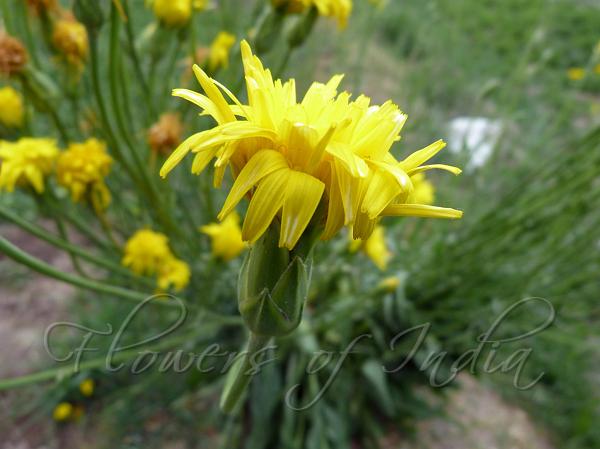|
| Black Salsify |
|

|

| File size | 356850 |
| Original date | 6/27/12 5:18 PM |
| Resolution | 2048 x 1536 |
| Flash | Flash did not fire, auto |
| Focal length | 4.5mm |
| Exposure time | 1/100s |
| Aperture | 3.2 |
| Focus Distance | |
| Metering Mode | Multi-segment |
| Camera make | Panasonic |
| Camera model | DMC-FZ40 |
| Sensor type | OneChipColorArea |
|
|
|
|
Photo: |
Botanical name: Pseudopodospermum hispanicum Family: Asteraceae (Sunflower family)
Synonyms: Scorzonera sativa, Scorzonera edulis, Scorzonera hispanica
Synonyms: Scorzonera sativa, Scorzonera edulis, Scorzonera hispanica
Black salsify is a perennial herb up to 3-4 ft
tall. The stems are solitary or few in number, usually branched on the
upper part. The leaves are broad, long, and narrow. They are 12-40 cm
long, 3-6 cm broad, margins entire or wavy. The yellowish flower-head
are borne at the end of the stems. The flower-heads have yellow ray
flowers. The thin black taproot grows up to 1 m long and up to 2 cm in
diameter. It has a black skin with white internal flesh. The black
salsify is native to Southern Europe and the Near East, cultivated in
parts of India. The thick black skin of the salsify root is usually
considered inedible and can be removed either prior to or after
boiling. If the skin is removed prior to boiling, the peeled root
should be immediately immersed in water mixed with vinegar or lemon
juice, in order to prevent discolouring. Since the root sap is an
extremely sticky latex, it is often more convenient to peel it after
boiling the root for 20 to 25 minutes. Black salsify is often eaten
together with other vegetables, such as peas and carrots. But it is
also popular served like asparagus in a white sauce, such as bechamel
sauce or mustard sauce. Boiled salsify roots may also be coated with
batter and deep fried.
| Identification credit: Gurcharan Singh | Photographed in Nubra Valley, Ladakh. |
• Is this flower misidentified? If yes,